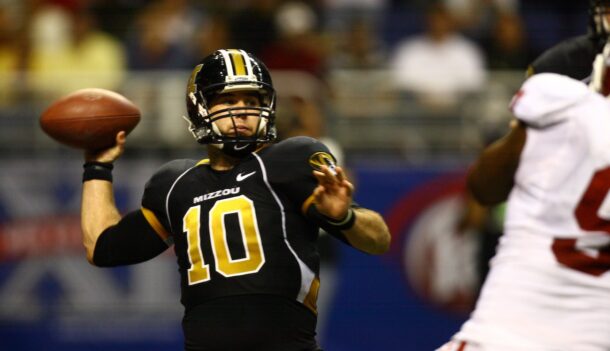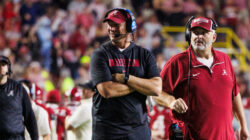
With Derrick Henry and even Leonard Fournette assaulting SEC record books, it makes sense to try to contextualize their seasons.
How will history remember them?
That’s a difficult question to answer. With the sport in a constant state of transition, most comparisons are apples to oranges. Many of these subjective debates seem to center around personal biases geared toward favorite teams and players. Some discount players that they didn’t watch firsthand.
But there have been some spectacular seasons by SEC running backs since 2000. So we decided to rank the 10 best:
1. 2007 Darren McFadden (Arkansas)
Stats: 1,830 rushing yards, 21 receptions, 4 touchdown passes and 11.2 yards per attempt on 11 passes, 21 total touchdowns
Honors: Walter Camp Award, Doak Walker Award, unanimous first-team All-American, Heisman Trophy runner-up to Tim Tebow, SEC Offensive Player of the Year
You want durability? McFadden carried 325 times. Explosiveness? McFadden had a long run of at least 20 yards in 10 different games. Versatility? He almost single-handedly created a fascination with the “Wildcat” offense throughout college football and the NFL. In 22 collegiate passes, McFadden threw 7 touchdowns, an incredible ratio.
McFadden was must-watch TV in the SEC. One cannot eliminate the exhilaration factor, as McFadden could do anything on any play. He was a four-way threat, including kickoff returns. His running totals more or less equal Henry’s this year through 13 games. But he was so much more than just a runner.
2. 2015 Derrick Henry (Alabama)
Stats: 1,986 rushing yards, 23 rushing touchdowns
Honors: Heisman Trophy, Doak Walker Award, Walter Camp Award, Maxwell Award, SEC Offensive Player of the Year, unanimous first-team All-American
His games against Auburn and Florida epitomized Henry’s season. He ran the ball a combined 90 times at 5.1 yards per carry and scored two touchdowns.
It’s a chore to tackle the 6-foot-3, 242-pound Henry, who also has good breakaway speed. Although he’s churned out several long runs this year, mostly he accumulates huge totals by plunging between the tackles time and again, bouncing off one, two or three would-be tacklers every single carry.
Once Alabama realized that its defense was elite once again, the passing game needed to avoid mistakes and there wasn’t a tremendous No. 2 backfield option, coach Nick Saban and coordinator Lane Kiffin rode Henry’s strong back all the way to the College Football Playoff.
If the Tide beat Michigan State, Henry could break Herschel Walker’s record for carries in a single season.
3. 2006 Darren McFadden (Arkansas)
Stats: 1,647 rushing yards, 7 of 9 passing for 3 touchdowns and 1 interception, 92-yard kickoff return for touchdown
Honors: Doak Walker Award, Jim Brown Trophy, Heisman Trophy runner-up to Troy Smith, consensus All-American, SEC Offensive Player of the Year
This was the season Arkansas truly unveiled the Wildcat offense. McFadden managed to score at least one touchdown as a runner, receiver, passer and kick returner, a rare feat. He led the Razorbacks to an also-rare SEC West title.
All that despite entering the season with a dislocated toe stemming from an incident at a Little Rock night club. His 219 rushing yards against South Carolina represented a career high. He lost a paper-thin Heisman Trophy vote to Ohio State quarterback Troy Smith, edging out Notre Dame’s Brady Quinn for second.
4. 2015 Leonard Fournette (LSU)
Stats: 1,741 yards, 18 rushing touchdowns, 209 receiving yards
Honors: Consensus All-American, first-team All-SEC
Keep in mind that these figures are prior to LSU’s bowl game against an awful Texas Tech run defense, and also do not include the canceled season opener against McNeese State. Take away that weather cancelation and Fournette probably is looking to notch a 2,000-yard, 20-touchdown season in the bowl game.
As it stands, Fournette still has a shot at Herschel Walker’s single-season rushing record, which now actually belongs to Henry. Speaking of Henry, if not for the Tide running back — and Bama’s tremendous run defense — all of Henry’s awards could easily be Fournette’s.
His offensive line is mostly good, but it isn’t nearly as dominant as the ones that Mark Ingram and Trent Richardson ran behind. And Alabama’s quarterback play and defense were better in those seasons as well, which is why Fournette gets this spot.
5. 2009 Mark Ingram (Alabama)
Stats: 1,658 rushing yards, 17 rushing touchdowns, 334 receiving yards, 3 receiving touchdowns
Honors: Heisman Trophy, unanimous All-American, SEC Offensive Player of the Year
Ingram achieved his yards on fewer carries and behind an offensive line that didn’t feature quite as many road graders as the 2011 version.
Oh yeah, and Ingram was a clear first option on a team that included Julio Jones, Trent Richardson and others.
The running back also should get credit for being a part of the initial turnaround as a member of the team’s famous 2008 recruiting class. Prior to that class, coach Nick Saban was a megastar, but the Tide had won 10 games in a season just twice since 1999.
Ingram was a game-changer for the program, winning its first-ever Heisman Trophy and leading the team to a 14-0 record and a national title.
6. 2011 Trent Richardson (Alabama)
Stats: 1,679 rushing yards, 21 rushing touchdowns, 338 receiving yards, 3 receiving touchdowns
Honors: Doak Walker Award, unanimous All-American, SEC Offensive Player of the Year
Barrett Jones, Chance Warmack, William Vlachos, Anthony Steen and D.J. Fluker did not quite represent the all-time great offensive line that the 2012 team enjoyed.
Still, that combination of blockers and Richardson helped Alabama to its second national championship under head coach Nick Saban. Richardson did not return kickoffs like he did backing up Mark Ingram in 2010, but he was an impressive option as a pass-catcher, averaging 11.7 yards per catch.
Say what you will about his NFL career, but while his knee was still healthy, Richardson was an explosive back. Faster than Ingram in college, he ran a 10.81-second 100-meter dash in high school, and people forget how fast he was in Tuscaloosa. He also scored a combined 24 touchdowns in 2011, a school record that Henry hasn’t broken yet.
7. 2014 Nick Chubb (Georgia)
Stats: 1,547 rushing yards, 7.1 yards per carry, 14 rushing touchdowns, 213 receiving yards, 2 receiving touchdowns
Honors: SEC Freshman of the Year, first-team All-SEC, Belk Bowl MVP
If not for a devastating knee injury, Chubb’s 2015 season could’ve rivaled that of Henry and Fournette, and turned it into the best year for SEC running backs of all-time.
His 2014 season also comes with a major caveat in that he did not start until Oct. 11 against Missouri due to Todd Gurley’s suspension. During the course of the next 13 games, he ran for 2,068 yards and 20 touchdowns, adding another two scores on the ground.
Do that within the confines of one schedule cycle and Chubb would have arguably the best single season in SEC history.
Still, Chubb’s 14 touchdowns on just 219 carries, along with his 7.1 yards per rush, in ’14 are darned impressive on their own merit.
8. 2000 Rudi Johnson (Auburn)
Stats: 1,567 rushing yards, 13 rushing touchdowns
Honors: SEC Player of the Year
Future NFL ball-carriers Heath Evans and Ronnie Brown played for the Tigers in 2000. Johnson was so good, they managed a combined 48 carries.
He lost the Doak Walker Award to a certain LaDainian Tomlinson, but still did yeoman’s work at 5-foot-10 and 227 pounds, carrying the ball 324 times.
Johnson was the No. 1 offensive option on a team that won the SEC West without a single 375-yard receiver. Nicknamed the “Auburn Rambler,” his hard-nosed style fit the 2000 Auburn team well. They were going to try to beat you in a physical brawl, and despite entire defenses trying to corner him, Johnson slammed into opponents like a battering ram.
9. 2001 Travis Stephens (Tennessee)
Stats: 1,464 rushing yards, 10 rushing touchdowns, 19 receptions
Honors: First-team All-American, first-team All-SEC
Stephens powered a running game that propelled Tennessee to an SEC East title and an 11-2 season, though he missed one game.
His 291 carries and 1,464 rushing yards established single-season school records. He ran for more than 200 yards twice and also produced 254 yards of total offense against Georgia. Listed at just 5-foot-9 and 190 pounds, Stephens played much bigger during his senior season.
10. 2007 Felix Jones (Arkansas)
Stats: 1,160 rushing yards, 8.7 yards per carry, 11 touchdowns, 16 receptions, 647 kickoff return yards and 2 kickoff return touchdowns
Honors: Consensus All-American, SEC Special Teams Player of the Year
Remember when Todd Gurley ran 123 times for 911 yards in 2014, earned himself a first-round NFL draft spot and everyone said, “what if he’d gotten a few more carries?”
Well, in 2007, Jones got 11 more carries than Gurley did in ’14. And he nearly gained the necessary distance for a first down every time he ran the ball, averaging 8.7 yards per carry. No one in SEC history ever has done that while carrying at least 100 times.
Let’s say Arkansas doubled his carries that year, but he lost a yard and a half off his average. He still would’ve rushed for 1,930 yards and about 20 touchdowns.
The kicker is that Jones was one of the best kick returners in the nation in ’07, even returning two for touchdowns. He earned a spot on this list through his efficiency and the ability to affect the game in three different ways, as he was a steady receiver as well.
HONORARY MENTION: 2013 TRE MASON (AUBURN)
Mason’s stats belong in the top 10, for the box score readers. He carried the ball a whopping 317 times, which is impressive. A massive 46 of those came in the SEC Championship Game against Missouri, against whom he ran for 304 yards.
His season total of 1,816 will remain at least fifth in SEC history after this season is over — though I doubt anyone would say that his ’13 season was better than Bo Jackson in ’85 or Herschel Walker in ’82, players who rank directly behind him on that list.
When Mason left Auburn, Cameron Artis-Payne rotated in the next season and led the SEC in rushing with 1,608 yards in 2014. When Nick Marshall was quarterback and Auburn ran the read-option, this team’s running game was very, very difficult to defend.
The offensive line was pretty great, but lead blocker Jay Prosch was an underrated key to Mason’s success. In fact, the 6-foot, 258-pound H-back arguably has been the best lead blocker in the SEC in the 21st century.
Mason’s ’13 season was outstanding. But he was a system back who got tons of carries and benefitted from a 14-game season. He is the easiest omission to argue from the list, but I do not think his ’13 season is one of the 10 best in the SEC since 2000.
An itinerant journalist, Christopher has moved between states 11 times in seven years. Formally an injury-prone Division I 800-meter specialist, he now wanders the Rockies in search of high peaks.







